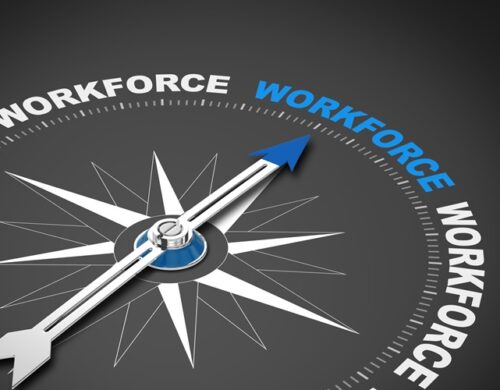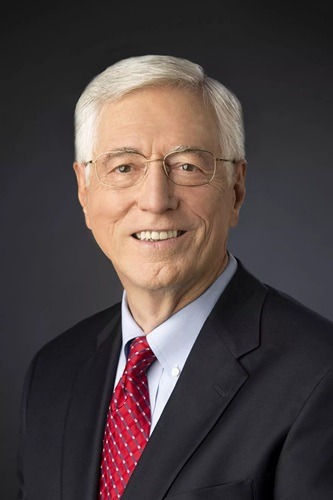
9.27.24 – KGOU –
TRANSCRIPT
Dick Pryor: This is Capitol Insider – taking you inside politics, policy, and government in Oklahoma. I’m Dick Pryor with Quorum Call publisher Shawn Ashley. And our guest is Dr. Robert Dauffenbach, professor emeritus at the Price College of Business at the University of Oklahoma. Bob, good to have you with us again today.
Dr. Robert Dauffenbach: Great to be here.

Shawn Ashley: Bob, we spoke with you in early August about the state of the national economy. You were cautiously optimistic there. Have there been any significant changes since that time?
Dr. Robert Dauffenbach: Yes, indeed. Something very significant happened on September 19th. The Fed lowered the interest rates on the federal funds rate, which is their targeted policy rate, from five and a quarter to five-point-seven five percent. Now, that’s a half point drop, and generally, people were expecting only about a quarter point reduction. And so that’s been a very substantial change. Now we have to recognize where interest rates have gone over this period of about two and a half years. Beginning in March of 2022, the Fed began its interest rate climb and raised interest rates a full five percentage points – the highest and most rapid rate of increase in interest rates in the history of the Fed. And they also reversed their policy of quantitative easing that that is, they had been buying a lot of securities in the pandemic year and now they started turning that around and selling securities. And that has, of course, the tendency to bring up interest rates and very, very much so.
So early on, the Fed was very much behind the curve. They were rightly criticized for that. And to their credit, they reversed course quickly and decidedly. But now we’re at another point. The labor market has started to show some weakness. And in consequence, the Fed is recalibrating. It’s looking at its dual objective of price stability and full employment. And it’s saying it’s time to turn course. And so, they’re not only talking about lowering interest rates that one half percentage point, but they’re talking about a program of continuing to lower rates. And I think they’re very correct in what they’re doing in this recalibration. So, hopes for a soft landing are abounding right now and financial markets seem very pleased.
Shawn Ashley: So, what does this mean? What do you think this will do to the economy?
Dr. Robert Dauffenbach: We have to remember there are policy lags. You can change policy. You can put it into effect, but you’re only going to marginally affect decision making on financial fronts. And certainly, those will continue into the future. But we certainly don’t expect any rapid rebounding of the economy prior to the election.
Dick Pryor: Should we continue to worry that the economy may be on the cusp of a recession?
Dr. Robert Dauffenbach: Always we should worry. Time tested indicators of recession have triggered – such as the Sahm Rule. Essentially, they’re based on the rate of change in the unemployment rate over historic levels. And we’ve seen unemployment rise from 3.4% in April 2023 to 4.2% in August. So, that’s a sign that the labor market is weakening. But we have to remember the 4% in my textbooks when I was studying and then teaching, 4% was always considered a fully employed economy. Now, signs of growth moderating are abounding. But we haven’t seen initial unemployment claims rise, which is typical when the onset of recession. Indeed, they’re falling somewhat. Full time employment is down one million workers since mid-2023. But it’s up 3 million workers since January 2024. Quit rates are rising, but not much different from historic levels. Job market gains and non-farm employment have fallen from the 250,000 level that we once knew. But they’re still higher, high enough to moderate growth in the labor force. Moreover, GDP forecasts are in the 2.5% real rate of growth in gross domestic product. Now, that’s hardly what I would call recessionary. It appears every sign of weakness that we see has a fairly convincing counterpoint.
Shawn Ashley: Within all this, how is the Oklahoma economy holding up?
Dr. Robert Dauffenbach: Well, the Oklahoma economy is holding up really well, particularly if you’re talking about the Oklahoma City metropolitan area. Statewide, nonfarm employment has risen by 4.3% since January 2020. Now, why do I pick January 2020 as the benchmark? Because that was prior to the pandemic. So, we’re looking at going through that full cycle of all the jobs we lost during the pandemic, the recovery, and whatnot and saying, well, where are we today relative to January 2020? And the answer is, statewide, we’re at 4.3%. So that’s pretty good. The nation is up 4.4%. So, we essentially match the nation. Oklahoma City metro – looking at it inside the state – well, it’s up 7.2% since that January 2020 date. Tulsa is up 3.3%. And the rest of the state was up only 1.8%. In year over year, Oklahoma City’s just this last year gaining employment 2.1% versus the national gain of 1.5%. So clearly, Oklahoma City is the growth gem in the state.
Dick Pryor: What concerns many business leaders about Oklahoma’s future?
Dr. Robert Dauffenbach: What we’ve seen a recent poll by the State Chamber of business leaders, and they found that 80% were expressing concern that workforce and education issues are hindering the state’s economic progress. Gaps in both soft and technical skills were noted, especially pronounced in positions not requiring a college degree. So there there’s growing concern about education and economic development.
Shawn Ashley: There’s been a lot of talk about workforce and there are several interim studies on workforce this year. Is Oklahoma doing enough on workforce development?
Dr. Robert Dauffenbach: Well, there’s a lot of activity. Certainly, as you see, Shawn, in your time, you spend there. But obviously mounting concern to the point that the Oklahoma Workforce Commission was established in 2023, the Legislative Evaluation and Development Committee – LEAD – the acronym there, was established in 2024. Legislation was created for the Oklahoma Office of Economic Development, Growth and Expansion to develop strategic plans. The Oklahoma Department of Commerce is being restructured. A lot of new acronyms flying about. Clearly, it’s a question of how well coordinated we are in our efforts and looking at all those elements of economic development that we need to be paying attention to. But certainly, a growing concern and we’ll hope appropriate attention and responsive, quick investigation of where we need to be going.
Dick Pryor: What do you recommend that Oklahoma policymakers do to improve the state’s workforce and job readiness?
Dr. Robert Dauffenbach: I’m always one for looking nationally. We talk about the 50 labs that we have in the nation – who’s doing exceptionally well with economic development? What are they doing? So, baseline, you’ve got to look at that, benchmarking to what’s going on in other states and regions. And I certainly think that would be a good quest. We have – a good place to start. There are good designs out there, I suspect. I haven’t investigated more recently. I mean, we look about – it was 40 years ago in the mid-80s that we faced similar crises regarding economic development, and we made a lot of changes then. So, it’s time for us to roll up our sleeves and look at what we’re doing, what returns are we’re getting off of what we’re doing, and what we need to do differently and how can we effectuate such changes.
Shawn Ashley: What concerns you most about the state’s economic future?
Dr. Robert Dauffenbach: Well, a number of things. But I’m concerned about fragmentation of economic development policy and in that and inadequate focus. And we’ve kind of kind of already talked about that. And so, I think we we need to increase our efforts there. I’m concerned about support for higher education. Adjusted for inflation, Oklahoma support for higher education in real terms has fallen by 60% since the mid-2000s, 2007, I think, was the peak year of support. And we are very much lagging by just about all states in the nation. We can bring up statistical evidence to show that being the case and it’s definitely going to hold us back. But education at all levels is the bedrock of economic development. And we certainly have to give more attention to what we’re doing and how well we’re doing it.
On a revenue front, we do a lot of hand-wringing about the Oklahoma income tax, failing to recognize its importance and fairness in state revenue generation. In FY24, total state revenues were down $1.33 billion, an 8.9% decline. Now, there was an economic weakness in 2023. And so that may be responsible nationally was some weakness that may have been a causal force in bringing down that rate. I don’t think we’re going to end up down that much this year and hopefully not down at all. But the individual income tax was the only major revenue source that was up, and it was up 3.8% and accounted for 39% of all state revenues. We want to be like Texas. Well, then adopt Texas’s property tax rates and we can forget about the Oklahoma income tax. We hate the property tax, but at our peril. With declining oil and gas severance taxes likely continuing, we have definite revenue problems in Oklahoma.
Dick Pryor: For sure. That’s a lot for policymakers to think about. Bob, thank you for joining us today.
Dr. Robert Dauffenbach: Glad to be here.
Dick Pryor: That’s Dr. Robert Dauffenbach, professor emeritus at the Price College of Business at the University of Oklahoma. For more information, go to quorumcall.online. You can find audio and transcripts at kgou.org. And look for Capitol Insider where you get podcasts. Until next time, with Shawn Ashley, I’m Dick Pryor.
Announcer: The candidates for November are set. “I know Donald Trump’s type.” Between now and Election Day. “We are not going back.” A campaign season unfolding faster. “Kamala Harris is not getting a promotion.”Than any in recent history. “Make America great again.” Follow it all with new episodes every weekday on the NPR Politics podcast.
KGOU is a community-supported news organization and relies on contributions from readers and listeners to fulfill its mission of public service to Oklahoma and beyond. Donate online, or by contacting our Membership department.
Tags
Capitol Insider state economyinflation

Dick Pryor has more than 30 years of experience in public service media, having previously served as deputy director, managing editor, news manager, news anchor and host for OETA, Oklahoma’s statewide public TV network. He was named general manager of KGOU Radio in November 2016.
